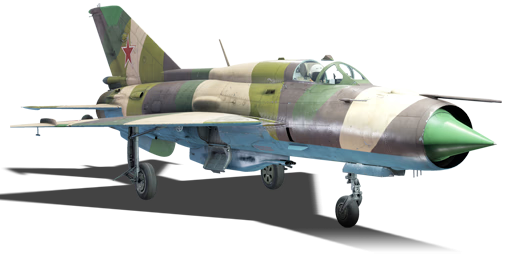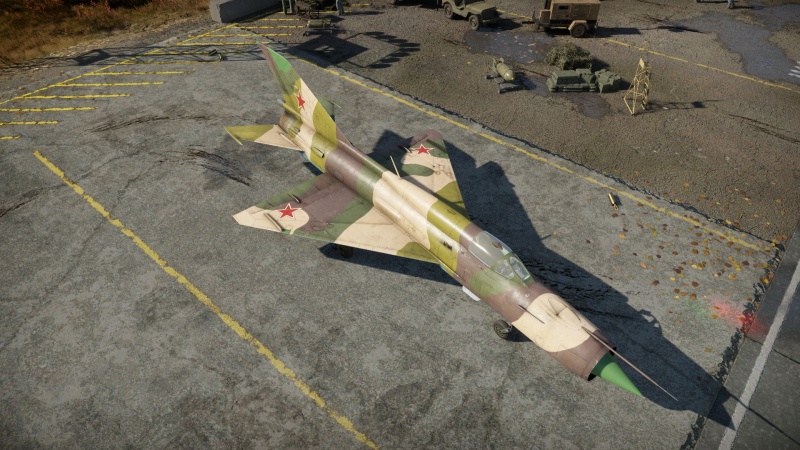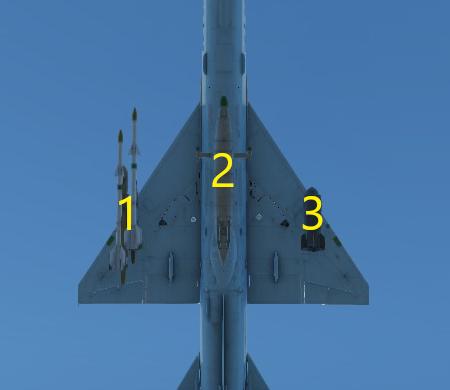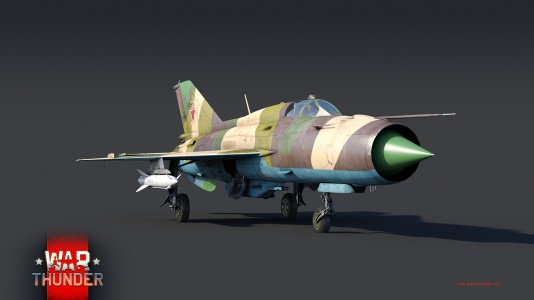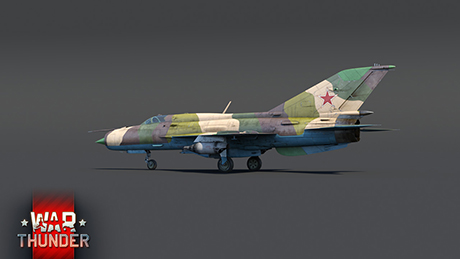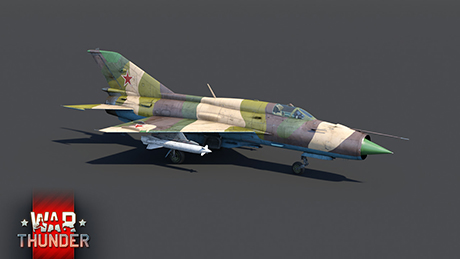Difference between revisions of "MiG-21PFM"
Colok76286 (talk | contribs) (→Flight performance: Updated stock values) |
(→Suspended armament: Updated) |
||
| (12 intermediate revisions by 7 users not shown) | |||
| Line 12: | Line 12: | ||
== Description == | == Description == | ||
<!-- ''In the description, the first part should be about the history of and the creation and combat usage of the aircraft, as well as its key features. In the second part, tell the reader about the aircraft in the game. Insert a screenshot of the vehicle, so that if the novice player does not remember the vehicle by name, he will immediately understand what kind of vehicle the article is talking about.'' --> | <!-- ''In the description, the first part should be about the history of and the creation and combat usage of the aircraft, as well as its key features. In the second part, tell the reader about the aircraft in the game. Insert a screenshot of the vehicle, so that if the novice player does not remember the vehicle by name, he will immediately understand what kind of vehicle the article is talking about.'' --> | ||
| − | The '''{{Specs|name}}''' | + | The MiG-21 (NATO Code: Fishbed) was a Soviet jet designed with the intent of replacing the older generation of subsonic fighters, which were becoming outdated and outperformed by their Western counterparts. It was developed in the 1950s and quickly became the most produced supersonic aircraft in history, with over 11,000 units built. The MiG-21 played a significant role in various conflicts around the world and was widely exported to many countries due to its affordability and effectiveness. The MiG-21PF series of aircraft was specialized for all-weather interception. It featured improved radar and avionics systems, allowing it to operate effectively in adverse weather conditions and at night. The aim of this series of aircraft was to mitigate potential dangers posed by enemy bombers and other high-altitude aircraft. Among these was the '''{{Specs|name}}''' variant, which further enhanced the capabilities of the MiG-21PF series. It underwent various improvements and reductions, including the elimination of an internally mounted gun and an inflated fuselage section. As a result, the aircraft relied on a GP-9 gun pod mounted on the belly as well as external armaments like missiles and rockets. |
| + | |||
| + | The {{Specs|name}} was introduced in [[Update "Hot Tracks"]] as a reward for the [[wt:en/news/6981-special-operation-w-i-n-t-e-r-en|2020 Operation W.I.N.T.E.R.]] event. Despite being equipped with a new RP-21M radar and 23mm GSh-23L cannons, the gameplay is very similar to that of the [[MiG-21F-13]]. One of the key strengths of the {{Specs|name}} lies in its performance at high altitudes. Its powerful engine and aerodynamic design allow for swift acceleration and excellent manoeuvrability in the skies. This also makes the aircraft ideal for boom-and-zoom tactics. Furthermore, it should be mentioned that the aircraft can perform light CAS from greater distances thanks to the addition of [[Kh-66]] missiles. | ||
== General info == | == General info == | ||
| Line 37: | Line 39: | ||
|- | |- | ||
! Upgraded | ! Upgraded | ||
| − | | 2,280 || 2,240 || 34. | + | | 2,280 || 2,240 || 34.5 || 36.0 || 167.0 || 145.0 |
|- | |- | ||
|} | |} | ||
| Line 132: | Line 134: | ||
{| class="wikitable" style="text-align:center" | {| class="wikitable" style="text-align:center" | ||
|- | |- | ||
| − | ! colspan=" | + | ! colspan="5" | [[Ballistic Computer]] |
|- | |- | ||
| − | ! CCIP (Guns) !! CCIP (Rockets) !! CCIP (Bombs) !! CCRP (Bombs) | + | ! CCIP (Guns) !! CCIP (Rockets) !! CCIP (Bombs) !! CCRP (Bombs) !! EEGS |
|- | |- | ||
| − | | {{ | + | | {{Tick}} || {{Tick}} || {{Cross}} || {{Cross}} || {{Cross}} |
|- | |- | ||
|} | |} | ||
| − | |||
| − | |||
| − | |||
| − | |||
| − | |||
| − | |||
| − | |||
| − | |||
| − | |||
| − | |||
| − | |||
| − | |||
| − | |||
=== Suspended armament === | === Suspended armament === | ||
{{Specs-Avia-Suspended}} | {{Specs-Avia-Suspended}} | ||
<!-- ''Describe the aircraft's suspended armament: additional cannons under the wings, bombs, rockets and torpedoes. This section is especially important for bombers and attackers. If there is no suspended weaponry remove this subsection.'' --> | <!-- ''Describe the aircraft's suspended armament: additional cannons under the wings, bombs, rockets and torpedoes. This section is especially important for bombers and attackers. If there is no suspended weaponry remove this subsection.'' --> | ||
| − | |||
| − | |||
The '''''{{PAGENAME}}''''' can be outfitted with the following ordnance: | The '''''{{PAGENAME}}''''' can be outfitted with the following ordnance: | ||
| − | * | + | {| class="wikitable" style="text-align:center" width="100%" |
| − | * | + | |- |
| − | * | + | ! !! width="15%" | 1 !! width="15%" | 2 !! width="15%" | 3 |
| − | * 2 x S-24 rockets | + | | rowspan="10" width="30%" | <div class="ttx-image">[[File:Hardpoints_MiG-21_SPS-K_(Germany).png]]</div> |
| − | * 2 x | + | |- |
| − | * 2 x | + | ! [[GSh-23L (23 mm)|23 mm GSh-23L]] cannons (200 rpg) |
| − | * 2 x 500 kg FAB-500M-54 bombs (1,000 kg total) | + | | || 1 || |
| − | * 2 x | + | |- |
| + | ! [[OFAB-250sv (250 kg)|250 kg OFAB-250sv]] bombs | ||
| + | | 1 || || 1 | ||
| + | |- | ||
| + | ! [[FAB-500M-54 (500 kg)|500 kg FAB-500M-54]] bombs | ||
| + | | 1 || || 1 | ||
| + | |- | ||
| + | ! [[ZB-360 incendiary]] bombs | ||
| + | | 1 || || 1 | ||
| + | |- | ||
| + | ! [[S-5K]] rockets | ||
| + | | 16 || || 16 | ||
| + | |- | ||
| + | ! [[S-24]] rockets | ||
| + | | 1 || || 1 | ||
| + | |- | ||
| + | ! [[Kh-66]] missiles | ||
| + | | 1 || || 1 | ||
| + | |- | ||
| + | ! [[R-3S]] missiles | ||
| + | | 1 || || 1 | ||
| + | |- | ||
| + | ! 490 l drop tanks | ||
| + | | || 1 || | ||
| + | |- | ||
| + | |} | ||
| + | |||
| + | {{Navigation-Start|Default weapon presets}} | ||
| + | {{Navigation-First-Simple-Line}} | ||
| + | * 1 x 23 mm GSh-23L cannon (200 rpg) | ||
| + | * 1 x 490 l drop tank + 2 x R-3S missiles | ||
| + | * 1 x 23 mm GSh-23L cannon + 2 x R-3S missiles | ||
| + | * 1 x 23 mm GSh-23L cannon + 32 x S-5K rockets | ||
| + | * 1 x 23 mm GSh-23L cannon + 2 x S-24 rockets | ||
| + | * 1 x 23 mm GSh-23L cannon + 2 x Kh-66 missiles | ||
| + | * 1 x 23 mm GSh-23L cannon + 2 x 250 kg OFAB-250sv bombs (500 kg total) | ||
| + | * 1 x 23 mm GSh-23L cannon + 2 x 500 kg FAB-500M-54 bombs (1,000 kg total) | ||
| + | * 2 x ZB-360 incendiary bombs | ||
| + | {{Navigation-End}} | ||
| + | |||
| + | The 23 mm GSh-23L cannon is attached to the {{PAGENAME}} as a gunpod at the belly, similar to the [[M61 (20 mm)|20 mm M61]] cannon on the [[F-4C Phantom II|F-4C]]. Despite the odd configuration, the armament firepower is not any lacking compared to the other MiG-21 variants, having more ammunition than the [[MiG-21F-13]]'s 30 mm and identical to the [[MiG-21SMT]]'s identical 23 mm in an internal mount. As such, new pilots simply need to compensate the odd firing angle of the belly-mounted gunpod to make the {{PAGENAME}} work in a dogfight. | ||
== Usage in battles == | == Usage in battles == | ||
| Line 179: | Line 206: | ||
However, the MiG-21PFM gets access to one more trick up its sleeve - the Kh-66 guided air-to-ground missiles. Packing an impressive punch, these missiles are mouse-guided, meaning that you can simply point the nose of the aircraft at the tank, launch the missile, and watch it explode. The missile itself is capable of destroying most ground targets at its BR with a single hit. Note that you must keep the aircraft's nose pointed at the target until the missile hits, meaning that you cannot pull out of a dive or other attack run until the missile has reached its target. | However, the MiG-21PFM gets access to one more trick up its sleeve - the Kh-66 guided air-to-ground missiles. Packing an impressive punch, these missiles are mouse-guided, meaning that you can simply point the nose of the aircraft at the tank, launch the missile, and watch it explode. The missile itself is capable of destroying most ground targets at its BR with a single hit. Note that you must keep the aircraft's nose pointed at the target until the missile hits, meaning that you cannot pull out of a dive or other attack run until the missile has reached its target. | ||
| − | ===Radars=== | + | === Radars === |
<!--{{main|AN/APS-19}}--> | <!--{{main|AN/APS-19}}--> | ||
| − | The MiG-21PFM is equipped with a | + | The MiG-21PFM is equipped with a Sapphire-21 search and tracking radar. The radar is mounted in the nose of the aircraft. |
{| class="wikitable" style="text-align:center" | {| class="wikitable" style="text-align:center" | ||
| − | ! colspan="4" | | + | ! colspan="4" | Sapphire-21 - Target Detection Radar |
|- | |- | ||
! {{Annotation|Maximum<br/>Detection<br/>Range|The maximum possible range at which a target can be detected}} | ! {{Annotation|Maximum<br/>Detection<br/>Range|The maximum possible range at which a target can be detected}} | ||
| Line 193: | Line 220: | ||
| 30,000 m<br />(theoretical) || 20,000 m || ±30.0° || -3.0°/+17.0° | | 30,000 m<br />(theoretical) || 20,000 m || ±30.0° || -3.0°/+17.0° | ||
|- | |- | ||
| − | ! colspan="4" | | + | ! colspan="4" | Sapphire-21 - Target Tracking Radar |
|- | |- | ||
! {{Annotation|Maximum<br/>Tracking<br/>Range|The maximum range at which a target can be tracked}} | ! {{Annotation|Maximum<br/>Tracking<br/>Range|The maximum range at which a target can be tracked}} | ||
| Line 213: | Line 240: | ||
* Very good acceleration, climb rate, and speed for its BR while still having decent manoeuvrability | * Very good acceleration, climb rate, and speed for its BR while still having decent manoeuvrability | ||
* Good manoeuvrability at high speeds | * Good manoeuvrability at high speeds | ||
| − | * Has a ballistic computer for rockets | + | * Has a ballistic computer for rockets |
'''Cons:''' | '''Cons:''' | ||
| Line 244: | Line 271: | ||
;Skins | ;Skins | ||
| − | * [https://live.warthunder.com/feed/camouflages/? | + | * [https://live.warthunder.com/feed/camouflages/?vehicle=mig-21_pfm Skins and camouflages for the {{PAGENAME}} from live.warthunder.com.] |
;Images | ;Images | ||
| − | |||
<gallery mode="packed" caption="MiG-21 PFM Devblog Images" heights="200"> | <gallery mode="packed" caption="MiG-21 PFM Devblog Images" heights="200"> | ||
File:MiG-21 PFM WTWallpaper 001.jpg| | File:MiG-21 PFM WTWallpaper 001.jpg| | ||
Latest revision as of 15:25, 22 June 2024
| This page is about the Soviet jet fighter MiG-21PFM. For other versions, see MiG-21 (Family). |
Contents
Description
The MiG-21 (NATO Code: Fishbed) was a Soviet jet designed with the intent of replacing the older generation of subsonic fighters, which were becoming outdated and outperformed by their Western counterparts. It was developed in the 1950s and quickly became the most produced supersonic aircraft in history, with over 11,000 units built. The MiG-21 played a significant role in various conflicts around the world and was widely exported to many countries due to its affordability and effectiveness. The MiG-21PF series of aircraft was specialized for all-weather interception. It featured improved radar and avionics systems, allowing it to operate effectively in adverse weather conditions and at night. The aim of this series of aircraft was to mitigate potential dangers posed by enemy bombers and other high-altitude aircraft. Among these was the MiG-21PFM variant, which further enhanced the capabilities of the MiG-21PF series. It underwent various improvements and reductions, including the elimination of an internally mounted gun and an inflated fuselage section. As a result, the aircraft relied on a GP-9 gun pod mounted on the belly as well as external armaments like missiles and rockets.
The MiG-21PFM was introduced in Update "Hot Tracks" as a reward for the 2020 Operation W.I.N.T.E.R. event. Despite being equipped with a new RP-21M radar and 23mm GSh-23L cannons, the gameplay is very similar to that of the MiG-21F-13. One of the key strengths of the MiG-21PFM lies in its performance at high altitudes. Its powerful engine and aerodynamic design allow for swift acceleration and excellent manoeuvrability in the skies. This also makes the aircraft ideal for boom-and-zoom tactics. Furthermore, it should be mentioned that the aircraft can perform light CAS from greater distances thanks to the addition of Kh-66 missiles.
General info
Flight performance
The MiG-21PFM has the same overall flight performance as other MiG-21s. It has strong acceleration and great climb rate at its BR allowing it to outclimb and outrun almost every aircraft it encounters. The aircraft has slightly upgraded performance over the prior MiG-21F-13 with a better climb rate. However, the aircraft has one major disadvantage: its turning ability. While it can certainly turn, the MiG-21PFM suffers from an absolutely terrible MER (Manoeuvring Energy Retention) that will make it bleed over half of its speed in turns. Thus, extended turn fights are not advised as the MiG-21 will be left slow and vulnerable to a follow-up missile attack.
The MiG-21 has a strong set of control surfaces including an all-moving tail, which keeps the aircraft responsive up to higher speeds (>1,300 km/h). However, be aware that the aircraft has two limiting structural factors - firstly, the aircraft will rip its wings at 1,300 km/h IAS, which it can reach at lower altitudes. Secondly, the aircraft has a 12-G structural limit. Stronger turns should thus be avoided as there is a chance that they will rip the aircraft's wings.
| Characteristics | Max Speed (km/h at 13,000 m) |
Max altitude (metres) |
Turn time (seconds) |
Rate of climb (metres/second) |
Take-off run (metres) | |||
|---|---|---|---|---|---|---|---|---|
| AB | RB | AB | RB | AB | RB | |||
| Stock | 2,210 | 2,195 | 16000 | 37.7 | 38.3 | 124.6 | 117.8 | 750 |
| Upgraded | 2,280 | 2,240 | 34.5 | 36.0 | 167.0 | 145.0 | ||
Details
| Features | |||||
|---|---|---|---|---|---|
| Combat flaps | Take-off flaps | Landing flaps | Air brakes | Arrestor gear | Drogue chute |
| X | ✓ | ✓ | ✓ | X | ✓ |
| Limits | ||||||
|---|---|---|---|---|---|---|
| Wings (km/h) | Gear (km/h) | Flaps (km/h) | Max Static G | |||
| Combat | Take-off | Landing | + | - | ||
| 1365 | 700 | N/A | 500 | 450 | ~12 | ~6 |
| Optimal velocities (km/h) | |||
|---|---|---|---|
| Ailerons | Rudder | Elevators | Radiator |
| < 650 | < 600 | < 900 | N/A |
Engine performance
| Engine | Aircraft mass | ||||||
|---|---|---|---|---|---|---|---|
| Engine name | Number | Basic mass | Wing loading (full fuel) | ||||
| Tumansky R-11F2S-300 | 1 | 5,692 kg | 342 kg/m2 | ||||
| Engine characteristics | Mass with fuel (no weapons load) | Max Takeoff Weight | |||||
| Weight (each) | Type | 10m fuel | 20m fuel | 30m fuel | 35m fuel | ||
| 1,120 kg | Afterburning axial-flow turbojet | 6,340 kg | 6,906 kg | 7,513 kg | 7,852 kg | 9,500 kg | |
| Maximum engine thrust @ 0 m (RB/SB) | Thrust to weight ratio @ 0 m (WEP) | ||||||
| Condition | 100% | WEP | 10m fuel | 20m fuel | 30m fuel | 35m fuel | MTOW |
| Stationary | 3,536 kgf | 5,304 kgf | 0.84 | 0.77 | 0.71 | 0.68 | 0.56 |
| Optimal | 3,536 kgf (0 km/h) |
5,398 kgf (1,200 km/h) |
0.85 | 0.78 | 0.72 | 0.69 | 0.57 |
Survivability and armour
The MiG-21PFM does not have more than the basics to ensure its survival.
Armour is paltry for the pilot, with a 60 mm bulletproof glass in their direct front cockpit window, and a 10 mm steel plate behind the pilot's head. The rear armour plate is not in an ideal location either; shots aiming for penetrate that plate from the front will go through the pilot (knocking out the plane instantly). If shots to the plate come from the rear, the tail or fuel tanks are going to be hit first before the pilot, which can cripple the aircraft.
All fuel tanks on the MiG-21PFM is self-sealing, which is good news if the aircraft gets grazed by a heavy machine gun bullet. However, the fuel tanks make up a good portion of the aircraft surface area inside the thin fuselage and the wings. A hit by a cannon at any of these locations, if they do not cripple that area of the plane, will certainly light one of the fuel tanks on fire and cause devastating damage that will more likely than not spread and destroy the plane.
The MiG-21PFM does not have flares neither any radar warning receiver. This means the MiG-21PFM has a distinct disadvantage when fighting against enemies with infrared missiles, radar, or radar-guided missiles. A pilot needs to constantly keep an eye out of their rear from any enemy firing an infrared missile, and their direct front/sides for any aircraft firing a SARH missile.
Damages to the engine are also not sustainable, as there will be significant loss in plane control. If a pilot is not flying the MiG-21PFM at a high-enough altitude, there's a more than likely chance the plane will descend into the ground.
Modifications and economy
Armaments
| Ballistic Computer | ||||
|---|---|---|---|---|
| CCIP (Guns) | CCIP (Rockets) | CCIP (Bombs) | CCRP (Bombs) | EEGS |
| |
|
|
|
|
Suspended armament
The MiG-21PFM can be outfitted with the following ordnance:
| 1 | 2 | 3 | ||
|---|---|---|---|---|
| 23 mm GSh-23L cannons (200 rpg) | 1 | |||
| 250 kg OFAB-250sv bombs | 1 | 1 | ||
| 500 kg FAB-500M-54 bombs | 1 | 1 | ||
| ZB-360 incendiary bombs | 1 | 1 | ||
| S-5K rockets | 16 | 16 | ||
| S-24 rockets | 1 | 1 | ||
| Kh-66 missiles | 1 | 1 | ||
| R-3S missiles | 1 | 1 | ||
| 490 l drop tanks | 1 |
| Default weapon presets | |
|---|---|
| |
The 23 mm GSh-23L cannon is attached to the MiG-21PFM as a gunpod at the belly, similar to the 20 mm M61 cannon on the F-4C. Despite the odd configuration, the armament firepower is not any lacking compared to the other MiG-21 variants, having more ammunition than the MiG-21F-13's 30 mm and identical to the MiG-21SMT's identical 23 mm in an internal mount. As such, new pilots simply need to compensate the odd firing angle of the belly-mounted gunpod to make the MiG-21PFM work in a dogfight.
Usage in battles
The MiG-21PFM was designed to be a fighter-interceptor, similar to the earlier F-13, and thus all of its design features shape it into virtually a missile with a cockpit. Thus, it is quite effective in air battles in the interceptor role. However, note that this MiG-21 gets access to the Kh-66 guided air-to-ground missiles making it a viable option for ground battles as well.
In air battles, one good strategy is to utilise its excellent speed and rate of climb and gain altitude and begin to level off when you are either at bomber altitude or just above any enemy fighters flying around. It is here you can use the great Boom & Zoom qualities of the aircraft and select a target and begin to dive on it. It is during this phase when you can attempt to get a lock with the R-3S air-to-air missiles and launch it or you can strafe any unwary targets with the GSh-23L cannon. Extremely short bursts are a must in order to conserve ammunition as the guns have an absurdly high fire rate. Once shots have been taken, regardless if they hit or missed, engage the afterburner and return to higher altitudes and set up for another Boom & Zoom run. Boom & Run techniques also work in that you can use the phenomenal speed of the MiG-21PFM to outrun almost every aircraft at its BR.
The MiG-21PFM gets access to several ordnance options such as bombs and rockets, which make it quite viable for ground battles. When attacking ground targets with unguided ordnance, it is best to place the MiG-21 into a relatively shallow dive, it is important to remember to properly line up for the target ahead of time because with the external ordnance fine-tune manoeuvring can be difficult especially when corrections need to be made at the last minute. Lack of a bombsight makes smaller targets a bit more difficult to hit. When flying low to take on ground targets, make sure you leave yourself an out when the situation turns bad. The best practice here is to ensure you keep your speed up, slow enough to hit the target, but fast enough to get away if the situation turns.
However, the MiG-21PFM gets access to one more trick up its sleeve - the Kh-66 guided air-to-ground missiles. Packing an impressive punch, these missiles are mouse-guided, meaning that you can simply point the nose of the aircraft at the tank, launch the missile, and watch it explode. The missile itself is capable of destroying most ground targets at its BR with a single hit. Note that you must keep the aircraft's nose pointed at the target until the missile hits, meaning that you cannot pull out of a dive or other attack run until the missile has reached its target.
Radars
The MiG-21PFM is equipped with a Sapphire-21 search and tracking radar. The radar is mounted in the nose of the aircraft.
| Sapphire-21 - Target Detection Radar | |||
|---|---|---|---|
| Maximum Detection Range |
Guaranteed Detection Range |
Max Azimuth Scan Angle |
Max Elevation Scan Angle |
| 30,000 m (theoretical) |
20,000 m | ±30.0° | -3.0°/+17.0° |
| Sapphire-21 - Target Tracking Radar | |||
| Maximum Tracking Range |
Minimum Tracking Range |
Azimuth Tracking Angle |
Elevation Tracking Angle |
| 20,000 m | 300 m | ±30.0° | ±17.0° |
Pros and cons
Pros:
- Good ordnance options including guided air-to-air and air-to-ground weapons
- Mouse-guided Kh-66 missiles allowing for long distance air-to-ground engagements
- Very good acceleration, climb rate, and speed for its BR while still having decent manoeuvrability
- Good manoeuvrability at high speeds
- Has a ballistic computer for rockets
Cons:
- Only 2 pylons for suspended weapons limit the total amount of ordnance
- Air-to-air weapons are underwhelming
- R-3Ss are short range and have low G-limits
- GSh-23L is mounted beneath the plane and has a low muzzle velocity of 710 m/s.
- Bleeds lots of energy in sharp turns due to its delta wing design
- Low amount of ammunition
- No flares or RWR
- Poor cockpit visibility in Simulator battles
History
Described as the "AK of airplanes", the MiG-21 is a robust, reliable, and easy to maintain jet fighter developed during the second generation of jet fighters that has since the 1950s earned a strong place in air forces of the Soviet Union as well as foreign operators such as North Korea, India, and Croatia. With many variants, the aircraft has had many life extensions over this 60+ year period of operation, with some aircraft in air forces having been in service for more than 30 years.
The story begins in 1953, when the Soviet government issued a requirement for a lightweight aircraft capable of Mach 2 for its Frontal Air division of the Soviet Air Force. Having had experience in the field of swept-wing, fast jet fighters Mikoyan-Gurevich felt confidently about their ability to produce such an aircraft. An aircraft such as the MiG-21 was only able to come to fruition after multiple test models and research with various prototypes. Beginning with the Ye-1 the Mikulin AM-11 turbojet was fitted, which in turn created another model called the Ye-50. This second one-off prototype was essentially a Ye-1 with the addition of the AM-9Ye turbojet in place of the AM-11, as well as adding liquid-fuelled rocket boosters for added thrust. After the initial prototypes, the Ye-2 was designed with the idea of using the original AM-11 turbojet, but was left waiting and soon opted to use the AM-9B found on the existing MiG-19 "Farmer" series of aircraft also produced by Mikoyan-Gurevich. This third aircraft was leads ahead of the previous models, having had development so far along that on February 14th, 1955 it took to the skies for the first time. This aircraft had good results, but was also slow as well leaving much to be built upon. With this, a similar aircraft called the Ye-4 was built and flown on June 16th that same year. This aircraft had many design implementations found on the final MiG design, such as the small-area delta wings and conventional tailplane. However, this prototype wouldn't be much of an improvement over the previous prototypes, only proving marginally better in terms of performance. With the first flight of both the Ye-5 and Ye-501 prototypes occurring on January 9th, 1956, Mikoyan-Gurevich was confident production would begin soon and issued two company designations for each model. These being MiG-21 for the delta-wing modification as well as MiG-23 for the swept-wing design, the latter not to be confused with the swing-wing supersonic aircraft also built by MiG.
The western world would finally get a peek at this development on June 24th, 1956 when variants of each design flew over during the Aviation Day celebration at the Moscow Tushino airfield. Taking notice of this, NATO and western observers would quickly take note, leading to NATO giving the codenames "Faceplate" and "Fishbed" to the swept and delta wing designs respectively. Development didn't end there however, as more prototypes were built and flown. Three Ye-6 aircraft were soon seen wearing the tailed-delta wing design seen on the previous Ye-5 but featuring clipped wingtips as well as a redesigned nose cone. With flight testing underway by May 20th, 1958, it was soon brought to a halt when the Ye-6/1 prototype lost its engine during a test flight. An effort was made by the test pilot to get it restarted but was in vain as the aircraft was lost, with the test pilot following shortly after injuries sustaining from the accident. However, with these setbacks testing and development would soon turn into production as the aircraft soon succeeded the requirement set by the Soviet government, hitting a speed of Mach 2.05. Production forms followed, and the western world would get a look in 1961 during a public appearance at the final production version of the MiG-21. The MiG-21 served continuously in the Soviet Air Force, and later the Russian Air Force, for many years following its introduction, orders and deliveries having been placed in 1957 that continued into the next year. While in service, the aircraft would first get the designation MiG-21F in 1959, and the aircraft would have a fruitful career with Russia as well as many foreign operators.
One notable example of the MiG-21, built off of the PFS airframe, was the PFM. This aircraft featured many improvements and reductions from the existing airframe. While retaining its ability for unpaved field operations this design featured the removal of the internal mounted gun under the nose. This variant also featured the addition of an inflated fuselage section behind the new split canopy design allowing for more space for electronics as well as fuel tanks within the fuselage. Stated before, it was designed without and internal gun forcing the aircraft to rely on suspended armaments such as missiles, rockets such as the RP-21M, and a belly-mounted GP-9 gun pod. Seeing production for the Soviet Air Force in Gorki from 1964 to 1965 and foreign production and export in Moscow from 1966 to 1968, the MiG-21PFM saw great success with foreign operators, seeing extended use throughout the years with air forces such as Poland, India, and Egypt in addition to the Soviet Union.
Devblog
During the modernization of the second generation of MiG-21 fighters, the Soviet military authorities demanded the design team to modify the aircraft for takeoff and landing from unpaved airfields. As a solution, the engineers proposed equipping the aircraft with a system for blowing the boundary layer from the flaps, and the Tumansky and Metskhvarishvili design bureau began developing a version of the R11F-300 engine with an air stream from the compressor. The boundary layer blowing system significantly improved the take-off and landing characteristics of the aircraft, the takeoff and run lengths were reduced, and the landing speed drastically reduced. Along with other modifications and improvements, the serial modification of the MiG-21 with the boundary layer blowing system began to be produced under the MiG-21 PFS index, later upgraded to the MiG-21 PFM version. Aircraft of this modification were produced in fairly large numbers since 1964, both for domestic use and export. The MiG-21 PFM served in Vietnam and Afghanistan.
Media
- Skins
- Images
- MiG-21 PFM Devblog Images
- Videos
See also
- Other members of MiG-21 series
- MiG-21F-13
- MiG-21SMT
- MiG-21bis
- J-7II - Chinese tech tree
- ▀MiG-21MF - German tech tree
External links
- [Devblog] MiG-21 PFM
- Official data sheet - more details about the performance
- [Military Factory] Mikoyan-Gurevich MiG-21 "Fishbed"
- [History Net] The Iconic MiG-21 "Fishbed"
| Mikoyan-Gurevich Design Bureau (Микоя́н и Гуре́вич Опытное конструкторское бюро) | |
|---|---|
| Fighters | MiG-3-15 · MiG-3-15 (BK) · MiG-3-34 |
| I-225 | |
| Jet fighters | MiG-9 · MiG-9 (l) |
| MiG-15 · MiG-15bis · MiG-15bis ISh | |
| MiG-17 | |
| MiG-19PT | |
| MiG-21F-13 · MiG-21PFM · MiG-21S (R-13-300) · MiG-21SMT · MiG-21bis | |
| MiG-23M · MiG-23ML · MiG-23MLD | |
| MiG-27M · MiG-27K | |
| MiG-29 · MiG-29SMT | |
| Export/Licensed | ␗MiG-9 · ␗MiG-9 (l) |
| ◊MiG-15bis · ◔MiG-15bis · J-2* | |
| MiG-17AS · ◔MiG-17PF · J-4* · Shenyang F-5* | |
| ◊MiG-19S · J-6A* | |
| ◄MiG-21 SPS-K · ◊MiG-21MF · ◔MiG-21MF · ▄MiG-21bis · ◔MiG-21bis-SAU · ◊MiG-21bis-SAU · ◊MiG-21 "Lazur-M" · ▄MiG-21 Bison · J-7II** | |
| ◊MiG-23BN · ◊MiG-23MF · ◔MiG-23MF · ◊MiG-23MLA | |
| ◔MiG-29 · ◊MiG-29 · ◄MiG-29G | |
| *Licensed and domesticated with Chinese designations. | |
| **Unlicensed, reverse-engineered and domesticated with Chinese designations. | |
| See Also | Shenyang · Chengdu |
| USSR jet aircraft | |
|---|---|
| Bereznyak-Isayev | BI |
| Yakovlev | Yak-15 · Yak-15P · Yak-17 · Yak-23 · Yak-28B · Yak-30D · Yak-38 · Yak-38M · Yak-141 |
| Mikoyan-Gurevich | MiG-9 · MiG-9 (l) · MiG-15 · MiG-15bis · MiG-15bis ISh · MiG-17 · MiG-17AS · MiG-19PT |
| MiG-21F-13 · MiG-21PFM · MiG-21S (R-13-300) · MiG-21SMT · MiG-21bis | |
| MiG-23M · MiG-23ML · MiG-23MLD · MiG-27M · MiG-27K | |
| MiG-29 · MiG-29SMT | |
| Lavochkin | La-174 · La-15 · La-200 |
| Sukhoi | Su-9 · Su-11 |
| Su-7B · Su-7BKL · Su-7BMK · Su-17M2 · Su-17M4 · Su-22M3 | |
| Su-24M | |
| Su-25 · Su-25BM · Su-25K · Su-25T · Su-25SM3 · Su-39 | |
| Su-27 · Su-27SM | |
| Su-34 | |
| Ilyushin | IL-28 · IL-28Sh |
| Tupolev | Tu-14T |


